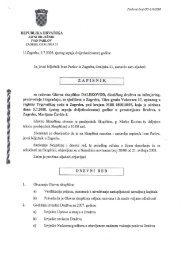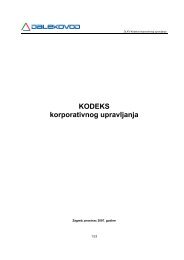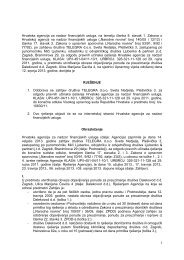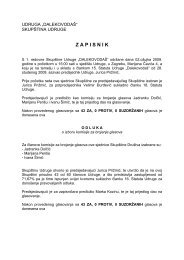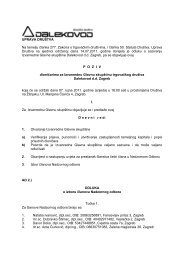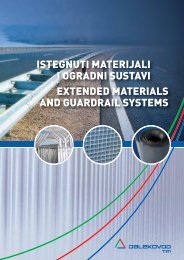laboratory orij laboratorij - Dalekovod dd
laboratory orij laboratorij - Dalekovod dd
laboratory orij laboratorij - Dalekovod dd
You also want an ePaper? Increase the reach of your titles
YUMPU automatically turns print PDFs into web optimized ePapers that Google loves.
<strong>Dalekovod</strong> - Laborat<strong>orij</strong> za elektromehanička i kemijska ispitivanja<br />
Material hardness testing<br />
Brinell hardness test according to HRN<br />
EN ISO 6506-1<br />
The clean and even surface of the test<br />
material is indented with a steel ball of<br />
diameter D (mm) subjected to a certain load<br />
F (N). The diameter of the indentation left in<br />
the test material is measured d (mm). The<br />
determination of hardness according to<br />
Brinell is recommended up to 450 HB.<br />
As for steel, its strength can be<br />
approximately calculated from the known<br />
Brinell hardness number HB.<br />
This method is appropriate for measuring<br />
the hardness of construction steel, coloured<br />
materials and alloys of coloured materials.<br />
Vickers hardness test according to<br />
HRN EN ISO 6507-1<br />
A pyramid-shaped diamond indenter is forced<br />
into a clean surface of a sample. The Vickers<br />
hardness HV number is calculated from the<br />
load force F (N) and the area of the indented<br />
pyramid faces determined by measuring the<br />
mean of the two diagonals.<br />
Due to a smaller indentation, this hard- ness<br />
testing method enables the test ing of very<br />
thin samples and reduces the damaging of<br />
the sample to the mini- mum.<br />
This method is used for measuring the<br />
hardness of the hardest steel materials.<br />
Hardness test for artificial materials<br />
(elastomers)<br />
The following methods are applied to test<br />
the hardness of artificial materials (rubber,<br />
plastics, rubber and plastic products):<br />
• for soft specimen (rubber) – Shore<br />
A method<br />
• for harder specimen (plastics) – Shore<br />
D method<br />
• for less hard materials, the IRHD<br />
method with a ball of a 5mm in<br />
diameter is applied.<br />
• for harder materials, the IRHD method<br />
with a ball of 2.5 mm in diameter is<br />
applied<br />
The Shore A or D hardness is<br />
determined from the position of a<br />
moved indenter that is dependent of the<br />
suppression (spring) force F.<br />
Rockwell hardness test according to<br />
HRN EN ISO 6508-1<br />
The clean surface of the test material is<br />
indented with a diamond cone.<br />
The Rockwell method consists of indenting<br />
the diamond cone into the surface of the test<br />
material under a certain load, measuring the<br />
depth of penetration.<br />
This hardness test method (HRC) is used for<br />
very hard materials.<br />
Laborat<strong>orij</strong> / Laboratory 7





